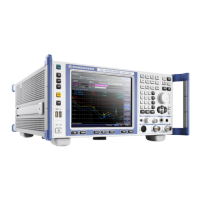Spectrum Measurements
R&S
®
ESR
399User Manual 1175.7068.02 ─ 12
with Avg = average trace; Curr = current trace
Due to the weighting between the current trace and the average trace, past values
have practically no influence on the displayed trace after about ten sweeps. With
this setting, signal noise is effectively reduced without need for restarting the aver-
aging process after a change of the signal.
●
sweep count = 1
The current trace is displayed. No averaging is performed. This is a special case of
Figure 6-17 with n = 0.
6.3.1.5 Detector Overview
The measurement detector for the individual display modes can be selected directly by
the user or set automatically by the R&S ESR. The detector activated for the specific
trace is indicated in the corresponding trace display field by an abbreviation.
For more information on available detectors see Chapter 5.2.2, "Detectors",
on page 167.
All detectors work in parallel in the background, which means that the measurement
speed is independent of the detector combination used for different traces.
Number of measured values
During a frequency sweep, the R&S ESR increments the first local oscillator in steps
that are smaller than approximately 1/10 of the bandwidth. This ensures that the oscil-
lator step speed is conform to the hardware settling times and does not affect the pre-
cision of the measured power.
The number of measured values taken during a sweep is independent of the number of
oscillator steps. It is always selected as a multiple or a fraction of 691 (= default num-
ber of trace points displayed on the screen). Choosing less then 691 measured values
(e.g. 125 or 251) will lead to an interpolated measurement curve, choosing more than
691 points (e.g. 1001, 2001 …) will result in several measured values being overlaid at
the same frequency position.
RMS detector and VBW
If the RMS detector is selected, the video bandwidth in the hardware is bypassed.
Thus, duplicate trace averaging with small VBWs and RMS detector no longer occurs.
However, the VBW is still considered when calculating the sweep time. This leads to a
longer sweep time for small VBW values. Thus, you can reduce the VBW value to ach-
ieve more stable trace curves even when using an RMS detector. Normally, if the RMS
detector is used the sweep time should be increased to get more stable trace curves.
6.3.1.6 ASCII File Export Format
The data of the file header consist of three columns, each separated by a semicolon:
parameter name; numeric value; basic unit. The data section starts with the keyword
"Trace <n>" (<n> = number of stored trace), followed by the measured data in one or
Analysis

